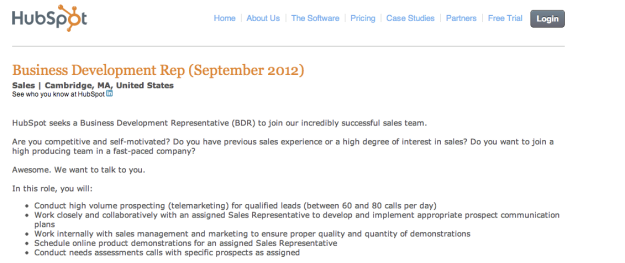A lot has been written about inbound marketing this year. Hubspot defined the space as earning the attention of prospects, making yourself easy to be found and drawing customers to your website. Google put an exclamation point on “inbound” with the release of Penguin algorithm that prioritizes search ranking based on social media such as Google+. This paradigm shift away from outbound marketing (cold calling, direct mail, tv advertisements) and toward inbound have left marketers and sales people left asking “Is there still a place for sales calls?”
A quick visit to Hubspot’s website reveals the answer to this question to be an unequivocal yes. Just look at the position they are hiring for:
You’ll notice Hubspot describes that their business development reps will make between 60 to 80 outbound calls per day. There still is a place for making sales phone calls in business. However, the terms in which these calls are conducted have changed.
Here’s how:
People know what they want, when they want it, and how they want it. The advent of the Internet has enabled buyers to do much more research before they ever talk to a salesperson. This is where the importance of inbound marketing comes in. Your business needs to be searchable and earn the attention of prospects. The Hubspot software suite is one of the best on the market to accomplish this goal with numerous lead scoring and content management features.
When your prospect finally makes their decision to learn more about a service you it is crucial to have a salesperson available. At this point the prospect has opted into the sales process (either by filling out a webform on a website or requesting additional information in some way). After they opt into the sales process it is appropriate  to have a sales person call them. InsideSales.com has one of the market leading sales communication software that allows sales people to call leads within seconds of a webform being filled out or when a lead reaches a certain score.
to have a sales person call them. InsideSales.com has one of the market leading sales communication software that allows sales people to call leads within seconds of a webform being filled out or when a lead reaches a certain score.
In closing inbound marketing and outbound calling are not diametrically opposed models, but instead two different models that can compliment each other when executed correctly.